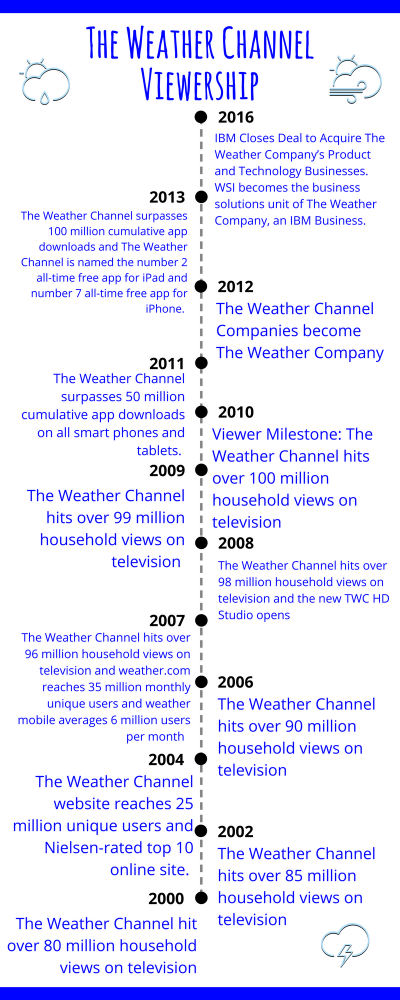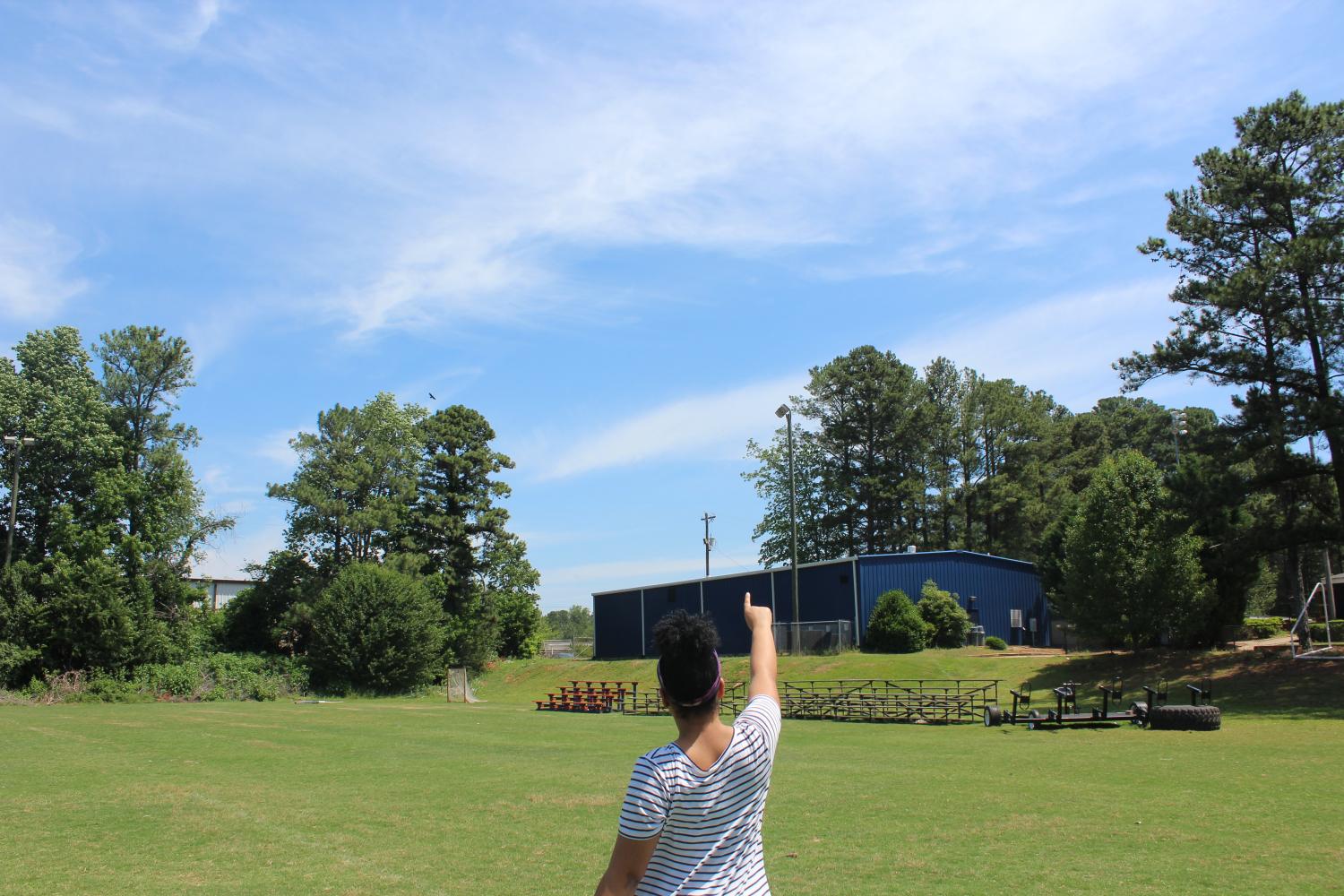Your donation will support the student journalists of North Cobb High School. Your contribution will allow us to purchase equipment and cover our annual website hosting costs.
Under the weather (channel)
May 18, 2017
Everyday people check the weather to plan their day. Will it rain? Should they dress for ninety degrees or twenty? Although weather reports vary in accuracy, they shape how humans go about their everyday lives.

This infographic shows the definitions of various national and graphic programs that I use in the article. This infographic may help you understand more about the article and the background of The Weather Channel.
TWC Through History
Atlanta-based company The Weather Channel (TWC) earns the title as one of the most world-renowned weather providers. They began on May 2, 1980 with an eight p.m. weather report presented by Bruce Edwards and André Bernier to not only the United States, but also international audiences.
Originally, the company used the National Oceanic and Atmospheric Association (NOAA) and the National Weather Service to create local forecasts to broadcast. For almost nine years, TWC operated with this system. Throughout these nine years, they launched their first major image campaign, utilizing their slogan “You Need Us For Everything You Do.”
Within a few years of the channel’s start-up, TWC did not do as well as they hoped. Many of its creators almost pulled the plug, but after long deliberation, the company decided to stay on air. Drastic changes made after the threatening of removal include adding an anchor and debuts of more live video footage.

This is a timeline of the views of the television channel and website, app downloads and company mergers from the early 2000s to present day. Each year has a major event or a major number of viewers in timeline.
Within the next year, TWC saw a forty-four percent increase in subscribers. Around this time WSI, now named The Weather Company, teamed up with the Environmental Satellite Data corporation to become the first company to provide satellite images displayed on television. The company also introduced the WeatherSTAR 4000, a system allowing the production team to utilize TWC’s logo as well as other graphics during each broadcast.
Shortly after their changes in presentation, the company started a toll-free telephone hotline in which anyone could call and get local forecast from over 1,000 international cities. This gave TWC the push they needed to produce accessible local forecasts for cities all over the world. They also created their website and a sequence titled “Local on the 8s,” in 1996, both actively used today.
Come 1997, the majority of graphics changes added to TWC’s production included the modernization of a new logo and a new graphics package, featuring rotating globes and new music. 1998 brought yet another refreshing change, with new and exciting fonts, a new look for Weather Scope, and the addition of Weather Center, a 24 hour running show comprised of three different segments: “commuter, business and travel,” “ongoing weather,” and “the next day’s weather.”
Later in the year, the company introduced new graphics for a program called Weather Star XL. This program provided an updated version of the STAR model that allowed for newer, higher quality graphics, consistent with TWC’s national graphics and scalable icons. In 1999, TWC discontinued their underperforming program, STAR 4000, for local weather updates and launched WeatherScan Local, a channel offering continuous weather information 24 hours a day, specialized exclusively by STAR units. The jazz and classical music heard on the weather channel introduced in 2000 went along with TWC’s Weather Star XL programs. To add to their local line-up, WeatherScan introduced a new feature that allowed a specialized view on more individual zones, beneficial to multi-county viewing.
June 2001 brought on a channel cleanse, meaning that the separate morning Weather Center AM and nighttime Weather Center PM programs discontinued, and in its place Weather Center created a continuous program. Furthermore, they introduced newer programs like Evening Edition and Weekend Now.
Weather Star XL received another revamp that included the addition of colors on text boxes, new backgrounds, new fonts and title bars to match the on-air graphics and improved regional forecast and radar maps. The early 2000s brought more long-form programs separate from the basic weather or a documentary, including Storm Stories, It Could Happen Tomorrow, and The Climate Code. In 2000, TWC became the first provider to deliver custom weather alerts to desktop, mobile, and landline phones. In 2005, the company changed its logo to the one seen today.

The late 2000s brought new changes including TWC’s transition to high-definition. The last part of graphics updates came with a program called Intellistar and IntelliStar 2 that closely resembles the graphical display of a mobile app. TWC cancelled First Forecast, Day Planner, Weekend View, and Weekend Now and replaced them with additional broadcasts of Weather Center Live, with more long-form television programming.
TWC also debuted several slogans over the years, including “No Place on Earth Has Better Weather,” “Live By It,” “Bringing Weather to Life,” and the current slogans, “Weather All The Time” and “It’s Amazing Out There.”
Changes on TWC occur every few years and keep up with changing technology and broadcast information. Television shows and specials aired on the channel dedicated to the TWC range from hurricane coverage to Tornado Chasers. In 2015, TWC launched a program called Local Now, which provides localized weather, traffic, and news distributed to over-the-top streaming services. Finally, in 2016, TWC merged with the International Business Machines Corporation (IBM) and officially became The Weather Company.
TWC Today
Today, TWC receives its information from similar sources to when it first started, and to create and make forecasts, the meteorologists look at multiple models. The creators consistently update their models, which means that meteorologists update the forecasts just as fast.
“The Weather Channel gets weather data from several sources, including public domains such as NOAA and the National Weather Service, and weather data from our sister company WSI. The models are not always accurate, and can vary greatly from model to model and run-to-run of each model. For example, the two models we look at most frequently include the American GFS model, and the European model (known as the EURO or ECMWF model),” Kathryn Prociv, Meteorology Content Producer for TWC, said.
Because forecasts change often and meteorologists cannot set weather in stone, the TWC responds with professionalism when approached with negative reactions from viewers about inaccurate weather forecasts.
“While our models are considered top models, they can vary immensely in their forecast input especially the farther out you go in time since the farther in the future you get, the less accurate the forecasts become. We handle backlash with professionalism, and constantly try to explain and reiterate the uncertainty that is inherent to weather forecasting,” Prociv said.
TWC strives to update everyone on the weather for their everyday activities. The information must provide people with ample warnings for severe weather and enough information to understand the weather around them.
“It’s important that we educate viewers on how models vary, because they’re based on different factors. As a predictable measurement, a model is designed to predict potential danger. Having every possible scenario at your disposal is always better for people to protect themselves and their families,” Director of Content Development for TWC Scott Tufts said.
Local Impact
The Weather Channel focuses itself nationally and internationally, but also includes local forecasts in day-to-day operations. When watching TWC, they often go region by region pointing out important trends and certain areas likely to see precipitation during the day.
“Yes, The Weather Channel constantly tries to highlight local issues. In fact, we just kicked off a new initiative called “Local Now” where we are doing specific and local forecasts for cities like New York, Dallas, and Atlanta,” Prociv said.
The new emphasis on local news gives TWC a market in individual cities and helps them fine tune their information.
“We definitely have more impact locally. People care what’s in their backyard more than they care about something on the other end of the country,” Tufts said.
TWC utilizes numerous forms of communication to speak with other meteorological professionals and reach out to people on local levels. Most often, TWC uses social media to answer specific questions about different areas. Community outreach also plays a big part and TWC utilizes programs and elements to create a local impact.
“Social media is huge in my role, where I use Twitter to communicate with meteorologists across local TV markets as well as answering people’s questions regarding local impacts on their communities around the country. My specific content includes communicating with people via social media as well as performing community outreach like speaking to area schools,” Prociv said.
Every time a local citizen checks the whether, or whether or not to wear short sleeves or grab an umbrella, behind the screen or phone lies a team of meteorologists working hard to bring the most accurate information to the city’s fingertips.
